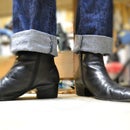Introduction: Ye Olde Holdfast
Before steel vises, before iron clamps, and before the industrial revolution, before even the fall of Rome, there were holdfasts; innocuous bent iron bars with the potential to hold a workpiece firmly in place while a craftsperson goes to town on it. The holdfast holds a few advantages over modern work-holding tools. It drops into a hole in the top of a bench, giving it an extended reach across the bench top and a 360 degree range of direction. Application is a simple drop and a tap with a mallet, giving it an instant grip. No manual tightening. Release is a simple strike in the back. And a holdfast keeps a low profile; some will lay nearly flat across a workpiece and won't interfere with planing or routing.
I make all my holdfasts at TechShop.
Step 1: Aquire
Materials:
Mild steel round bar
1/4" plate steel
Oxide patina finish
Tools:
Metal saw
Piper bender
Welder
Angle grinder
Metal file
The bar stock you will start with should be 1/8" smaller than the hole it will fit into. My bench has 3/4" holes so I'm using 5/8" stock. The general formula for measuring how much you will use is to multiply the desired reach of the tool by 1.5 then add the thickness of the bench top it will mount in, then add the maximum thickness of what you would want to be able to hold with it plus a few more inches as a margin of error. The pictured holdfast has a 7" reach, mounts in a 5" thick top and maxes-out at 6" so I started with a bar 22" long. Some holdfasts have a more extreme curve and some make a sharp bend at nearly 90 degrees and will require more or less length.
Mild steel or ductile forged iron are best since the holdfast will need to bend and spring slightly. Do not use brass, cast iron, aluminum, or stainless steel a they are either too brittle or too soft, or both.
Step 2: Bend
The geometry involved is surprisingly complicated. The straight part of the shaft needs to extend above the bench surface when the holdfast is resting flat. But because the shaft is smaller than the hole, it will rest at an angle so the pad needs to dip lower than the start of the bend.
Step 3: Cutting the Pad
I cut the pad from 1/4" plate steel using the CNC water jet cutter at TechShop. If you don't have a TechShop in your area, you can use a metal blade on a miter saw or jig saw to rough-out the general shape then refine the piece with an angle grinder. Holdfast pads are often square or leaf-shaped. I'm opting for a leaf-shaped pad because elves.
Step 4: Weld
The 1/4" plate will require some penetration on the part of the welder, I found that 18 volts did the job. There will be much grinding after this so don't be stingy with the beads.
Step 5: Grind
The bottom of the pad needs to be smooth, and the more contact it will have with the workpiece the stronger it will hold.
I used a hand file after grinding to further refine the shape.
Step 6: Patina
An iron oxide patina will insulate and protect the steel, and may have the secondary effect of passing it off as forged iron. I prepped the metal with a sandblasting. Twenty minutes after application I washed-off the patina solution, leaving a beautiful black surface.













